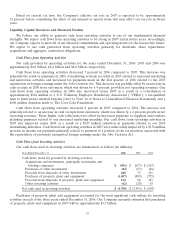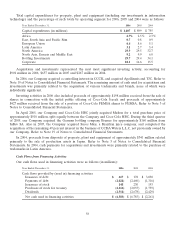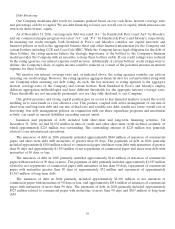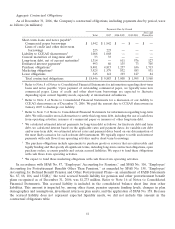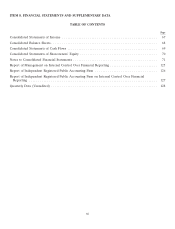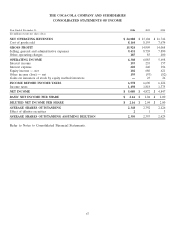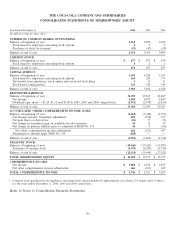Coca Cola 2006 Annual Report Download - page 67
Download and view the complete annual report
Please find page 67 of the 2006 Coca Cola annual report below. You can navigate through the pages in the report by either clicking on the pages listed below, or by using the keyword search tool below to find specific information within the annual report.ITEM 7A. QUANTITATIVE AND QUALITATIVE DISCLOSURES ABOUT MARKET RISK
Our Company uses derivative financial instruments primarily to reduce our exposure to adverse fluctuations
in foreign currency exchange rates and, to a lesser extent, adverse fluctuations in interest rates and commodity
prices and other market risks. We do not enter into derivative financial instruments for trading purposes. As a
matter of policy, all our derivative positions are used to reduce risk by hedging an underlying economic
exposure. Because of the high correlation between the hedging instrument and the underlying exposure,
fluctuations in the value of the instruments are generally offset by reciprocal changes in the value of the
underlying exposure. Virtually all of our derivatives are straightforward, over-the-counter instruments with
liquid markets.
Foreign Exchange
We manage most of our foreign currency exposures on a consolidated basis, which allows us to net certain
exposures and take advantage of any natural offsets. In 2006, we generated approximately 72 percent of our net
operating revenues from operations outside of the United States; therefore, weakness in one particular currency
might be offset by strengths in other currencies over time. We use derivative financial instruments to further
reduce our net exposure to currency fluctuations.
Our Company enters into forward exchange contracts and purchases currency options (principally euro and
Japanese yen) and collars to hedge certain portions of forecasted cash flows denominated in foreign currencies.
Additionally, we enter into forward exchange contracts to offset the earnings impact relating to exchange rate
fluctuations on certain monetary assets and liabilities. We also enter into forward exchange contracts as hedges
of net investments in international operations.
Interest Rates
We monitor our mix of fixed-rate and variable-rate debt, as well as our mix of term debt versus non-term
debt. From time to time we enter into interest rate swap agreements to manage our mix of fixed-rate and
variable-rate debt.
Value-at-Risk
We monitor our exposure to financial market risks using several objective measurement systems, including
value-at-risk models. Our value-at-risk calculations use a historical simulation model to estimate potential future
losses in the fair value of our derivatives and other financial instruments that could occur as a result of adverse
movements in foreign currency and interest rates. We have not considered the potential impact of favorable
movements in foreign currency and interest rates on our calculations. We examined historical weekly returns
over the previous 10 years to calculate our value-at-risk. The average value-at-risk represents the simple average
of quarterly amounts over the past year. As a result of our foreign currency value-at-risk calculations, we
estimate with 95 percent confidence that the fair values of our foreign currency derivatives and other financial
instruments, over a one-week period, would decline by approximately $14 million, $9 million and $17 million,
respectively, using 2006, 2005 or 2004 average fair values, and by approximately $14 million and $9 million,
respectively, using December 31, 2006 and 2005 fair values. According to our interest rate value-at-risk
calculations, we estimate with 95 percent confidence that any increase in our net interest expense due to an
adverse move in our 2006 average or in our December 31, 2006, interest rates over a one-week period would not
have a material impact on our consolidated financial statements. Our December 31, 2005 and 2004 estimates
also were not material to our consolidated financial statements.
65




